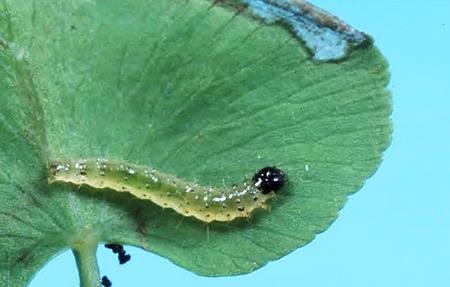The invasive Old World climbing fern was introduced to Florida’s ecosystem from southeast Asia around 1965. It soon dominated the state’s native vegetation, infesting more than 100,000 acres in a short amount of time. The fern spreads quickly and has destroyed numerous native plant populations, smothering trees and shrubs with vines that can grow up to 90 feet in length. You’ll now find this invasive fern throughout south and central Florida, specifically in wetlands and other habitats like the Everglades tree islands, bald cypress domes, and sawgrass prairies.
USDA-Agricultural Research Service (ARS) and the Commonwealth Scientific and Industrial Research Organization (CSIRO), Australian Biological Control Laboratory (ABCL), scientists began to search for a way to solve this agricultural challenge and soon found an answer to slow the fern’s spread.
ARS and ABCL researchers collected, identified, and tested caterpillars feeding on the Old World climbing fern in its native habitat. One species of fern-feeding snout moth, Neomusotima conspurcatalis, commonly known as the Brown lygodium moth,is a member of the subfamily of Musotiminae and has been a successful deterrent to this invasive fern. The Musotiminae belongs to the Crambidae family that have protruding labial palpi, or “noses,” giving the family the common name of “snout moths.” Most of the moths that ARS researchers discovered in southeast Asia were snout moths, which at that time, belonged to a subfamily that had not been studied by the Agency.

Southeast Asian fern-feeding larva or caterpillar.
“Early detection of potential invasive species is crucial so USDA can quickly implement strategies that protect U.S. agriculture, forestry, and the environment,” said ARS researcher Alma Solis. “This study led to the discovery of a number of new fern-feeding species and the identity of their caterpillars, which were previously unknown to science.”
ARS researchers studied the snout moth’s external wing patterns, dissected its insides, specifically the genitalia and wings, and compared it to other southeast Asian moth species. All of the snout moth’s immature stages, including larvae, and pupae, had never been seen before and were considered new to science. The research team also compiled a chart to compare adult and immature morphologies, host plants, and geographic distribution of the fern-feeding species. The findings permitted ARS to create criteria for biological control workers across the globe to distinguish Musotiminae species in their own countries or eco-systems. The snout moth was later introduced to Florida and slowed the spread of the Old World climbing fern with their eating habits.
ARS researchers, and research partners for the state of Florida, continue to study the interactions of snout moths with parasites, predators, and fungi. Together they are working together to deter the spread of this invasive fern throughout the nation and protect America’s native vegetation.
Source : usda.gov